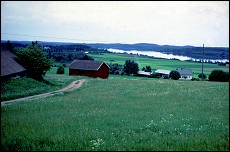
|
|
The village landscape of Tarnala is among South Karelia's nationally most valuable landscape areas. The settlement phases from different time periods represented in the village area reach from the Stone Age to the present. Picture, South Karelian Museum / Arto Hämäläinen.
|
The cultural landscape consists of nature as it is shaped by people and of the built environment, in which different time periods can be distinguished. The cultural landscape results from long, slow development. Antiquities are the oldest layer of the cultural landscape.
Today many relics, especially prehistoric ones, are difficult to distinguish from the surrounding countryside. For example, many dwelling sites are not visible from the surface of the ground. Other monuments may dominate the landscape, as do some of the ancient castles. At best, one can see the whole continuum of time in the same landscape, from the Stone Age to the present.
The cultural landscape is continually taking shape. It threatens to disappear amid unchecked vegetation, reforestation, and intensified agriculture and forestry. Construction that does not take into consideration the environment also damages it easily. By managing the cultural landscape we try to preserve the landscape in its richest form possible, as an enjoyable environment that evokes positive experiences.
